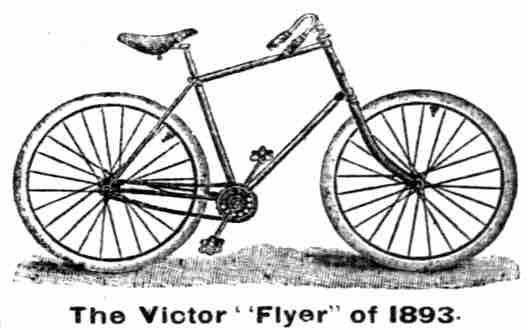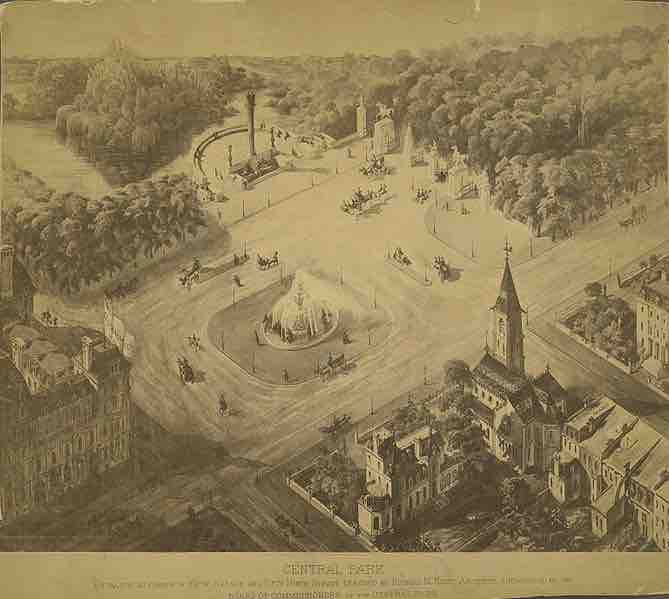The Bicycle
The 1890s experienced an enormous bicycle craze, driven by several significant developments in bicycles: the invention of the "safety bicycle" with its chain-drive transmission, whose gear ratios allowed smaller wheels without a concurrent loss of speed; and the subsequent invention of the pneumatic (inflatable air-filled) bicycle tire. Experiments with chain-drive had been attempted in 1869 and 1879, but the first well-known chain-drive bicycle was the "Rover" produced in 1885 by John Kemp Starley. Very quickly, the penny-farthing, or high-wheel, passed out of fashion, and multitudes of people all over the world began riding the "safety." It was largely the popularity of this type of bicycle at this time that precipitated the paving of roads.
September 13, 1892, saw the opening of a Bicycle Railroad between Mount Holly, New Jersey, and the H.B. Smith Manufacturing Company in Smithville, New Jersey, during the Mount Holly fair. The railroad had 3,000 riders its first week (for amusement instead of for commuting). Coney Island wanted one, and the World's Columbian Exposition in Chicago featured one. Several others were built for amusement in Atlantic City, Ocean City, and Gloucester City, New Jersey (the first two in 1893 and last in 1894). The application of the internal-combustion engine to the bicycle during the 1890s resulted in the motorcycle, and then soon after, the engine was applied to four-wheel carriages, resulting in the motor car or "automobile," which in later decades largely supplanted its unmotorized ancestor.

The Overman Victor "Flyer" bicycle
The Overman Victor Flyer was a popular safety bicycle during the 1890s.
Camping
The history of recreational camping often is traced back to Thomas Hiram Holding, a British traveling tailor, but it was actually first popularized in the United Kingdom on the river Thames. By the 1880s, large numbers of visitors took part in the pastime, which was connected to the late Victorian craze for pleasure boating. The early camping equipment was very heavy, so it was convenient to transport it by boat or to use craft that converted into tents.
Thomas Hiram Holding was responsible for popularizing a different type of camping in the early twentieth century. He experienced the activity in the wild from his youth, when he had spent much time with his parents traveling across the American prairies. Later he embarked on a cycling and camping tour with some friends across Ireland. His book on his Ireland experience, Cycle and Camp in Connemara led to the formation of the first camping group in 1901, the Association of Cycle Campers, later to become the Camping and Caravanning Club. He wrote The Campers Handbook in 1908, so that he could share his enthusiasm for the great outdoors with the world.
Camping as a recreational activity became popular among elites in the early twentieth century. With time, it grew more democratic and varied. Modern participants frequent publicly owned natural resources such as national and state parks, wilderness areas, and commercial campgrounds.
The International Federation of Camping Clubs was founded in 1932, and clubs from all over the world began affiliating with it. By the 1960s, camping had become an established family holiday standard, and today campsites are ubiquitous across Europe and North America.
Baseball
In the mid-1850s, a baseball craze hit the New York metropolitan area. By 1856, local journals were referring to baseball as the "national pastime" or "national game." A year later, 16 area clubs formed the sport's first governing body, the National Association of Base Ball Players, which lasted until 1875.
The National League was founded in 1876. As the oldest surviving major league, the National League is sometimes referred to as the "senior circuit." Several other major leagues formed and failed. In 1884, African American Moses Walker (and, briefly, his brother Welday) played in the American Association. An injury ended Walker's major-league career, and by the early 1890s, an unspoken "gentlemen's agreement" effectively barred black players from the white-owned professional leagues, major and minor. Professional Negro Leagues formed, but quickly folded. Several independent African-American teams succeeded as barnstormers.
The National League's first successful counterpart, the American League, which evolved from the minor Western League, was established in 1901. The two leagues, each with eight teams, were rivals that fought for the best players, often disregarding each other's contracts and engaging in bitter legal disputes. A modicum of peace was eventually established, leading to the National Agreement of 1903. The pact formalized relations both between the two major leagues and between them and the National Association of Professional Base Ball Leagues, representing most of the country's minor professional leagues.
The World Series, pitting the two major-league champions against each other, was inaugurated that fall, albeit without express major-league sanction. The Boston Americans of the American League defeated the Pittsburgh Pirates of the National League. The next year, the series was not held, as the National League champion New York Giants, under manager John McGraw, refused to recognize the major-league status of the American League and its champion. In 1905, the Giants were National League champions again, and team management relented, leading to the establishment of the World Series as the major leagues' annual championship event.
Frederick Law Olmsted
Frederick Law Olmsted (April 26, 1822–August 28, 1903) was an American landscape architect, journalist, social critic, and public administrator. He is popularly considered to be the father of American landscape architecture. Olmsted was famous for codesigning many well-known urban parks with his senior partner, Calvert Vaux, including Prospect Park and Central Park in New York City, as well as Elm Park (Worcester, Massachusetts), which is considered by many to be the first municipal park in America.
Olmsted not only created numerous city parks around the country, but he also conceived of entire systems of parks and interconnecting parkways to connect certain cities to green spaces. Two of the best examples of the scale on which Olmsted worked are the park system designed for Buffalo, New York, and the system he designed for Milwaukee, Wisconsin. Olmsted was a frequent collaborator with architect Henry Hobson Richardson, for whom he devised the landscaping schemes for half a dozen projects, including Richardson's commission for the Buffalo State Asylum.
In 1883, Olmsted established what is considered to be the first full-time landscape architecture firm in Brookline, Massachusetts. He called the home and office compound "Fairsted." It is now the restored Frederick Law Olmsted National Historic Site. From there, Olmsted designed Boston's Emerald Necklace, the campuses of Stanford University and the University of Chicago, as well as the 1893 World's Fair in Chicago, among many other projects.
New York City's need for a great public park was voiced by the poet and editor of the Evening Post (now the New York Post), William Cullen Bryant, and by the first American landscape architect, Andrew Jackson Downing, who began to publicize the city's need for a public park in 1844. Many influential New Yorkers expressed the need for a stylish place for open-air driving, similar to the Bois de Boulogne in Paris or London's Hyde Park. After an abortive attempt in 1850–1851 to designate Jones's Wood, in 1853, the New York legislature settled upon a 700-acre area from 59th to 106th Streets for the creation of the park, at a cost of more than $5 million for the land alone. The state appointed a Central Park Commission to oversee the development of the park, and in 1857, the commission held a landscape design contest. Frederick Law Olmsted and Calvert Vaux developed what came to be known as the "Greensward Plan," which was selected as the winning design. Olmsted began executing their plan almost immediately.

Plan for Central Park
Plan for the entrance to Central Park, ca. 1863.

Central Park
Horseback riding in Central Park.